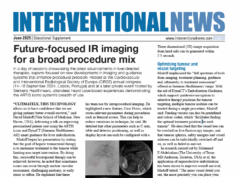
Sandeep Bagla (chair of Interventional Radiology at the Vascular Institute at Virginia, Woodbridge, USA) presented the results of an initial clinical study detailing his positive experience treating 20 patients with geniculate artery embolization (GAE) for mild to moderate knee osteoarthritis and moderate to severe pain at the annual scientific meeting of the Society for Interventional Radiology (SIR; 23–28 March, Austin, USA) earlier this year. This is the prelude to a second, ongoing, randomised controlled trial focusing on GAE—a larger cohort has just been approved by the US Food and Drug Administration (FDA). With this wealth of data on the horizon, an embolization registry is being launched with the hope of utilising artificial intelligence (AI) to predict patient outcomes.
Describing the initial pilot study to Interventional News, Bagla believes the results are promising: “We found that the vast majority of patients were responders, so 19 out of 20 patients demonstrated a significant improvement in pain. The average reduction in pain was around 65%. The improvement in disability and the improvement in physical function paralleled the change in pain scores.” All 20 patients were followed up to six months post treatment, and were assessed for pain, disability, and physical function. Imaging was also compared before and after embolization.
Sixty per cent of patients reduced their medications following the procedure. Bagla explains that “these patients were on a variety of medication— NSAIDS or opioids—and as the majority of patients were able to reduce these, I think this could have a big impact on the opioid crisis.”
“In terms of safety”, Bagla further comments, “there were a number of minor adverse events, the most common being transient skin discolouration, which occurs as a result of non-target embolization to cutaneous arteries. Two of our patients developed transient plantar numbness. Both of those patients were treated with a smaller sized particle, at 75 microns, so at that point we upsized our particle size to 100 microns, and we did not experience that [complication] further. Both of them resolved spontaneously in under two weeks, but they were eye opening in terms of us understanding what the potential complications could be.”
The investigators used a permanent embolic, Embozene (Boston Scientific), in this initial clinical study. Bagla says that this decision was informed by previous work in this space from Yuji Okuno and colleagues in Tokyo, Japan. Okuno et al used either the resorbable antibiotic imipenem/ cilastatin sodium or 75μm calibrated Embozene microspheres as the embolic agent in the transcatheter arterial embolization of 11 and three patients, respectively, suffering from mild to moderate knee osteoarthritis. “For us”, Bagla says, “the first natural step was to replicate and expand on what he had done, in terms of [using] a permanent embolic.”
However, a second, follow-up study is underway, with enrolment just completed, that will use a resorbable embolic, Optisphere (Medtronic). This is a randomised controlled trial comparing GAE against a placebo, with a scheduled 12-month follow-up. Twenty-one patients are enrolled, with 2:1 randomisation—14 patients will undergo embolization, and seven will have a sham angiogram procedure with catheterisation. After one month, if the patients who received the sham procedure have reported no improvements, they will be allowed to cross over to the embolization arm of the study and be embolized. “As those seven patients can be unblinded and receive the treatment, in reality, all 21 patients could potentially receive the treatment”, explains Bagla.
The US investigators have additionally recently received approval from the US Food and Drug Administration (FDA) for a much larger cohort study, which will roll out after the second study of 21 patients.
Desiring to make best use of this imminent wealth of data focusing on GAE and embolization as a whole, Bagla and his team are launching a global embolization registry. This registry will cover embolization for osteoarthritis as well as other forms, such as prostate artery embolization and uterine fibroid embolization. Bagla enumerates the benefits he believes a registry provides, saying that “Clinical trials can be criticised for their lack of ability to replicate the data in the real world. Many clinical trials are very well controlled, and have very strict inclusion and exclusion criteria, meaning that many patients are screened out. Registries allow practioners like myself, and others around the world, to collect real world data, so patients do not necessarily have to meet very strict criteria for enrolment and can be treated as part of their standard of care, where you are collecting information for all outcomes and adverse events. A registry also allows for large cohorts of patients. Now, you can get large cohorts of data from Asia, Europe, America, and pull the data together to perform more detailed analyses on subsets of patients. This enables you to determine which groups of patients do better.” He also hopes that data pooled in a registry will drive insurance coverage for the procedure.
The registry will be sponsored by JiggleMed, a software company that Bagla heads as CEO. JiggleMed is partnering with the artificial intelligence company Surgeri to collect, annotate and analyse the data. “Ideally”, Bagla enthuses, “this data will help us to predict which patients will do better. The future of our field is to gather this data in one place, and to use it to predict how individual patients will do. Annotating the data is a time-intensive process, but it is a project we are dedicated to.”










